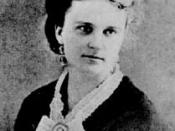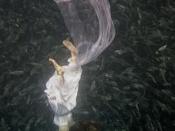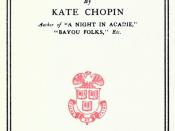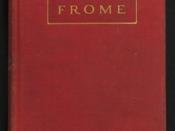Is independence an intangible dream? Are people truly individuals, or merely products of their environment? Edith Wharton and Kate Chopin explore the question in Ethan Frome and The Awakening, in which the protagonists are led by outside forces to challenge societal conventions. Employing the use of characterization, symbolism, and metaphor, the authors demonstrate that attempting to do so can lead to one's destruction.
The main characters in Frome and Awakening fill necessary roles and share similar attributes. Ethan is described as a loner, quiet, and uncomfortable interacting with people in town, even with Mattie, the woman he loves. He cowers in the formidable presence of his bitter wife, unwilling to defend himself against her wrath. Similarly, Edna feels out of place in both the relaxed Creole environment and stiff Victorian society. In many instances, she does not even understand herself and can't explain her behavior to family or friends. Both characters struggle to escape their surroundings.
Ethan dreams desperately of leaving Starkfield behind for the West while Edna builds her own dream house in favor of the "gilded cage"ÃÂ in which her husband placed her. The "villainess"ÃÂ of Wharton's novelette is Zenobia Frome, Ethan's wife. She is characterized repeatedly as embittered, inscrutable, and sickly. Her marriage to Ethan is loveless and she prefers nursing her many illnesses than keeping the company of her husband. Leonce Pontellier is Edna's controlling partner, intent on molding her into his ideal wife. He despairs over Edna's abandonment of convention, the absence of proper adulation toward him and lack of motherly devotion. To Leonce, Edna is a possession, an expensive commodity "'You are burnt beyond recognition,' he added, looking at his wife as one looks at a valuable piece of personal property which has suffered some damage."ÃÂ Mattie Silver in Frome and Robert Lebrun in Awakening play crucial roles in their respected stories. They are interlopers in unhappy marriages and possess all the qualities that Ethan and Edna long for. Mattie is the teasing, laughing cousin of Zeena. Her sparkling personality stands in sharp contrast against the Fromes'. She is associated with light and brings happiness into Ethan's bleak world. Robert Lebrun is the flirtatious Creole Edna falls in love with. His appeal is his careless sensuality and his careful attention of Edna and her whims. Although neither relationship is consummated, Mattie and Robert are symbols of life without constraint, of what could be if the chains of society were cast off.
Symbolism is found in many every day occurrences and items within Ethan Frome and The Awakening. Edith Wharton's use of snow and dreariness underlies the repeated symbol of death and decay. Most of the story takes place in the depths of winter, when life drains from plants and trees, when water stops flowing, and when living creatures hibernate. Even people, to escape winter, bury themselves inside small huts and houses. Although performing the basic functions of one alive, Zeena has cut herself off from the world. Figuratively, she is dead. After the smash-up, Mattie and Ethan entomb themselves with her in their small, meager shack. Another repetitive symbol is the color red. It constantly is in conjunction with Mattie; a ribbon in her hair, a scarf about her neck. ""æthrough her hair she had run a streak of crimson ribbon. This tribute"ætransformed and glorified her. She seemed"æmore womanly"æ"àThe bold color often appears when Ethan is feeling particularly passionate about his love for Mattie. It is a signature of her vitality and youthful energy. The antique pickle dish of Zeena's becomes an important symbol after it breaks. The fragile glass represents the Fromes shattered marriage, carelessly handled by Mattie. Ethan attempts to conceal the ruined dish by carefully placing the pieces next to each other, hiding it back on the shelf as if nothing is wrong. Zeena, with her discovery, places more value on a material object than on the relationships disintegrating around her. She mourns the destruction of an antique rather than her true loss: her marriage. Symbolism within The Awakening is a constant reminder of society. Madame AdÃÂèle Ratignolle is often described as the perfect society woman. She is beautiful, a loving mother, an adoring wife, and completely subservient to her husband's opinion. Madame Ratignolle would do anything for her children. In contrast, Edna claims that she would sacrifice her life for her children, but she would not sacrifice herself for them. While AdÃÂèle is the symbol for everything Edna should strive to be, she also serves as a figure of what Edna hopes to break free of as the story progresses. The Awakening opens with a parrot shrieking in two different languages. It is explained that the parrot possesses knowledge of a little French "a little Spanish, and also a language which nobody understood."àThe parrot symbolizes Edna and her life; forever caged in a role that does not suit her strong willed character. She acts (or "sings"ÃÂ), in ways that bewilder her peers. When Mademoiselle Reisz put her arms around Edna and felt her shoulder blades to see if her "wings were strong"àshe said "the bird that would soar above the level plain of tradition and prejudice must have strong wings. It is a sad spectacle to see the weaklings bruised, exhausted, fluttering back to earth."àThis serves emphasize the "caged bird"àtheme as well as foreshadow Edna's eventual fate. The most important piece of symbolism is the sea. The water simultaneously draws and repels Edna; she fears it, yet is seduced by its' hypnotic flow. Edna was unable to swim because she was afraid of abandoning herself to the sea. For her, learning to swim was a symbol of her sexual awakening and her desire to rebel against social conventions. She wants to swim "where no woman had swum before"àbut in her daring, swims further out than she intends and fear seizes her once again.
Sledding is an activity in which the rider may submit to gravity and the elements, or steer to alter course. This winter sport serves as an extended metaphor in Ethan Frome. In agreeing with Mattie's suicide plan, Ethan decides to steer and drive into the elm. As an endeavor fraught with danger, the sleigh ride serves as metaphorical sexual encounter. The structure is such that it imitates the intimate act. However, the end has unforeseeable and tragic consequences when the intended suicide goes wrong. Clothing during the Victorian era was restricting, binding: like cages. Throughout The Awakening Edna sheds more and more clothing through each scene, metaphorically removing herself little by little from society. In the beginning she is fully clothed but slowly trades the confining cloth for "simple muslin"ÃÂ dresses open at the throat, "light, commodious wrappers"ÃÂ and, finally, at the end, she stands naked upon the seashore. Rejected by Robert, who refuses to enter an affair with her, Edna enters the foaming waves to find liberation in suicide. Before the salty water closes over her, she spots a bird with a broken wing sinking into the surf. The bird symbolized Edna's failure to achieve the goal that had driven her throughout the novel. Freedom in death is the only choice society will allow her to make.
The inability to reconcile their desire for individual happiness to their need for social acceptance ultimately led Ethan and Edna to seek happiness through death, answering Edith Wharton and Kate Chopin's question of whether people can disentangle themselves from the confining clutches of their environment. None can truly escape societal expectations. One is pressured to concede their individuality for conformity. Defiance leads to a life of ostracism and unhappiness.





